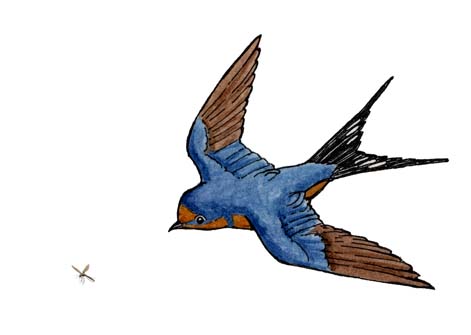

Adaptation in a population of living things happens as a result of an adaptive trait. This is any inheritable trait that increases its survival rate so that it can live longer, reproduce longer, and have more offspring (that also have that trait). Adaptive traits can improve an animal's ability to food, make a safer home, escape predators, survive cold or heat or lack of water.
A barn swallow’s diet is made up of tiny flying insects. These are not easy prey to catch midair. The barn swallow has to be a swift, agile flier. Barn swallows have developed adaptive traits that help them catch their prey. They have long, pointed wings and a long, forked tail. These physical adaptations have helped them become truly amazing fliers. Try to watch them while they hunt. They are almost too fast to watch!
The barn swallow's speed and agility in flight may also keep them from becoming prey. Birds of prey like the peregrine falcon, kestrel and broad-winged hawk all hunt birds. The swallow’s ability to change directions at high speeds helps it get away from winged predators as well as catch insects.
For Discussion and Critical Thinking:
The barn swallow has adaptive traits that help it catch the prey it needs to survive.
1. Name two of the barn swallow’s adaptive traits and how they help it survive:
2. Name two other animals that use speed to survive and how it helps them.
3. Name two other animals that snatch insects out of the air and how they do it.
When you research information you must cite the reference. Citing for websites is different from citing from books, magazines and periodicals. The style of citing shown here is from the MLA Style Citations (Modern Language Association).
When citing a WEBSITE the general format is as follows.
Author Last Name, First Name(s). "Title: Subtitle of Part of Web Page, if appropriate." Title: Subtitle: Section of Page if appropriate. Sponsoring/Publishing Agency, If Given. Additional significant descriptive information. Date of Electronic Publication or other Date, such as Last Updated. Day Month Year of access < URL >.
Amsel, Sheri. "Adaptations of the Barn Swallow" Exploring Nature Educational Resource ©2005-2024. December 13, 2024
< http://www.exploringnature.org/db/view/Adaptations-of-the-Barn-Swallow >

